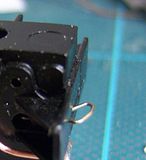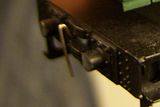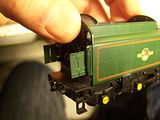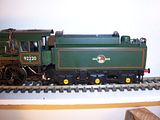I have a pair of 9Fs each with the BR1F tender. I've recently added some more vans to create a proper fast freight train - 24 vans in total. Although the 9Fs have no trouble at all with this load, it seems the bar coupling between engine and tender is not up to the job. The bar seems to repeatedly slip off the tender peg, leading to the rear of the tender lifting up. This causes both derailments and the tender separating from the train. I've tried swapping tenders between the two locos as well as with one from a standard 5MT but the result is always the same.
It looks to me like a design problem: the pin has to be short since otherwise the bar can't be attached to it through the opening in the tender drawbar slot. Has anyone else got the same problem, or better still has anyone devised a solution?
Thanks
It looks to me like a design problem: the pin has to be short since otherwise the bar can't be attached to it through the opening in the tender drawbar slot. Has anyone else got the same problem, or better still has anyone devised a solution?
Thanks









